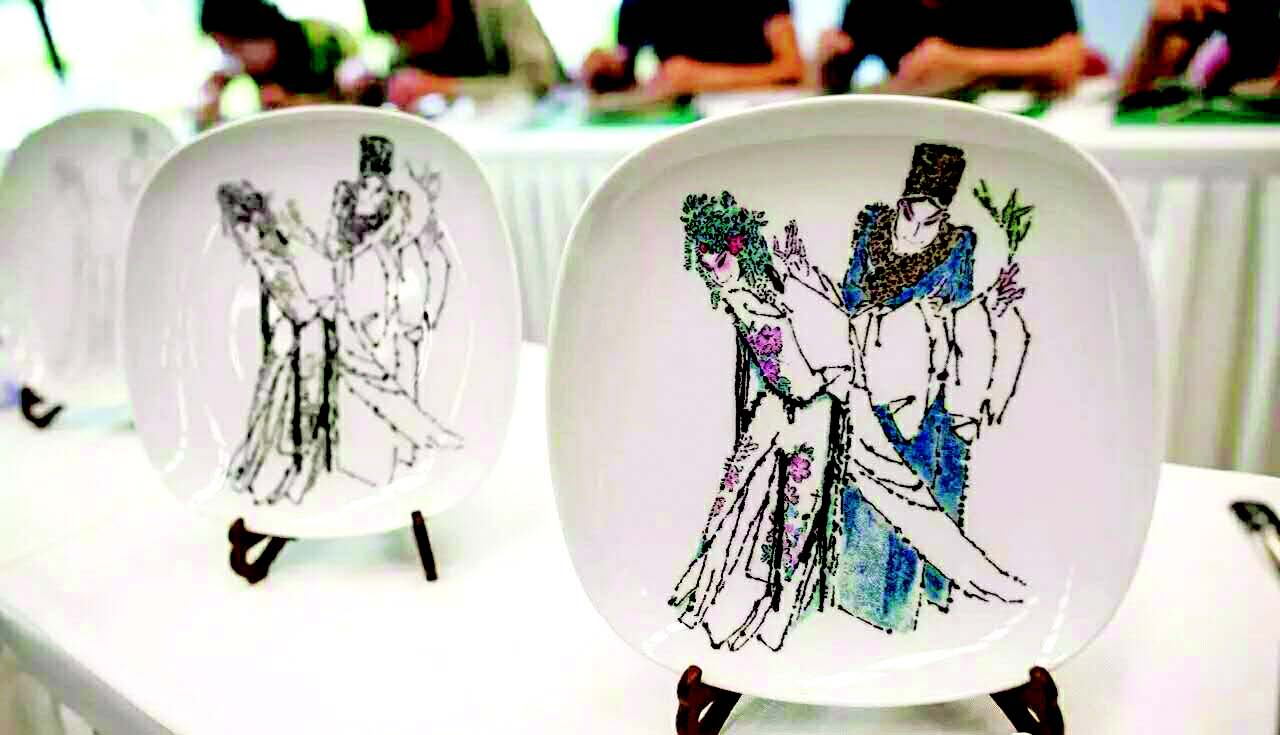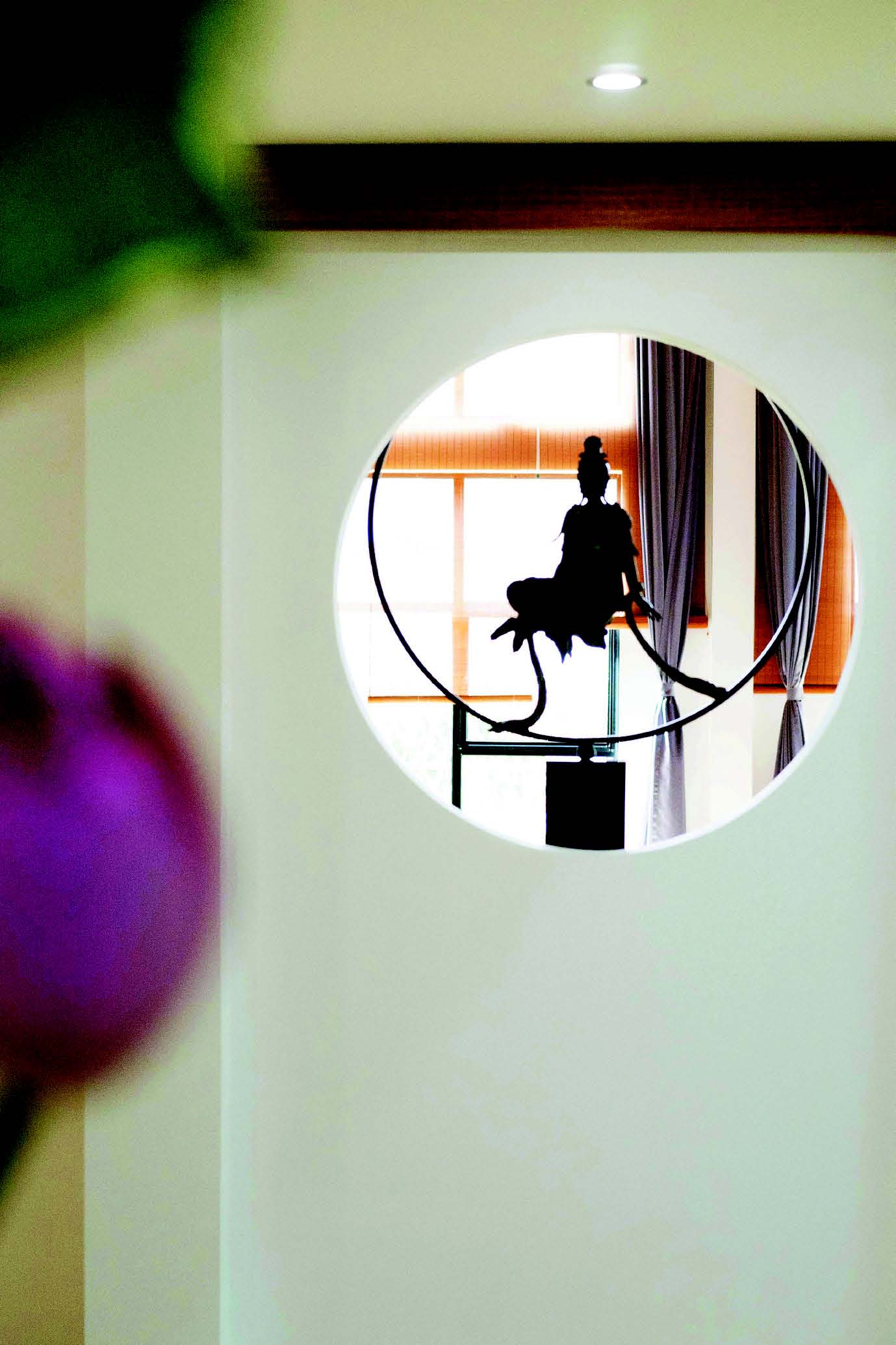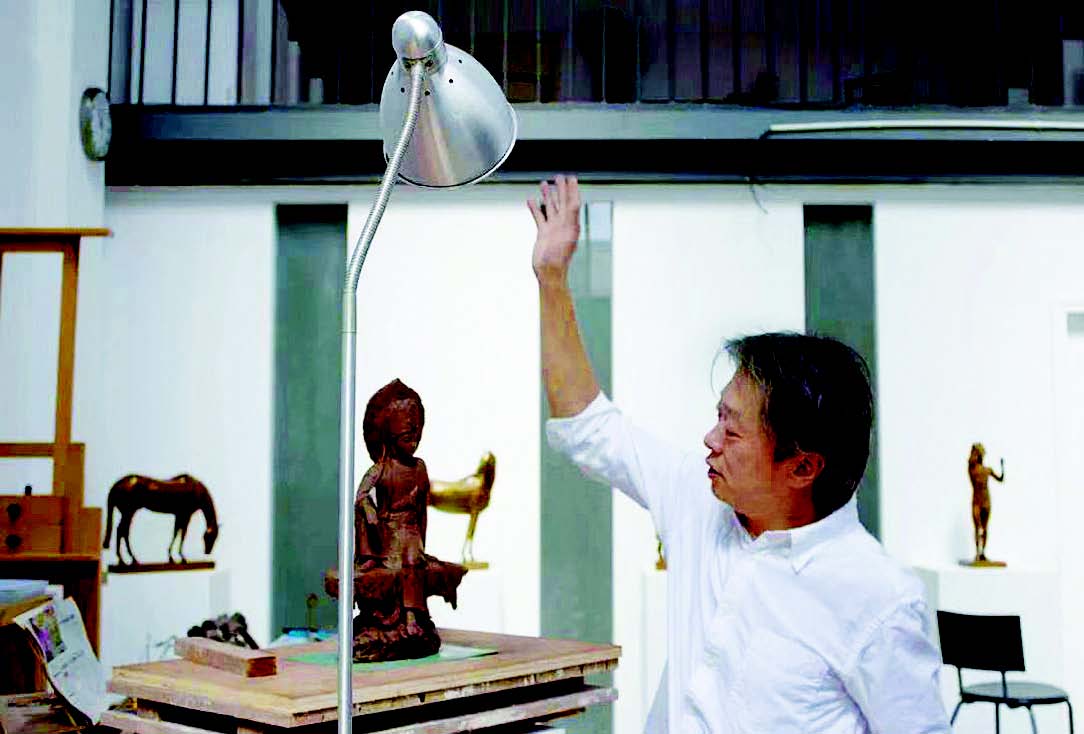

Community project aims to put art at the heart of people’s lifestyles

It showcases every step of painting plates.

The entrance of the Jiayuanhai International Art Community in Jading’s Malu Town features a dancing girl.

The teacher introduces the tea ceremony to the students.

Xue Qihua, an inheritor of Malu bamboo weaving, teaches students the basic skill of bamboo wearving in the Yiyuan center.

Artist Dong Yang is seen in his sculpture studio, which is the only studio in the community open to the public by appointment.
Liu Jingxian, Gu Xianhui and Li Huacheng
Art approached only through books, pictures or films can be a remote and detached concept. Jiayuanhai International Art Community in Jading’s Malu Town is offering people the chance to immerse themselves in art and comprehend the multiple relations between art and life.
An art community, when it develops and closely interacts with surrounding residential areas, ushers in a new lifestyle — galleries flourish, restaurants are filled with music, artists are passersby you greet on the street.
Jiayuanhai aims to be such a community.
At Malu Grape Culture and Art Village, Jiayuanhai International Art Community covers an area of 60,000 square meters, with a floor area of 10,000 square meters. In summer the aroma from the adjacent Malu Grape Theme Park fills the air.
So far, the community consists of a central exhibition hall, artists’ studios, Yiyuan Intangible Heritage Experiencing Center, Gaudi Barcelona restaurant and boutique B&Bs. While organizing art exchange activities, it also cooperates with art institutes and artists.
Art institutes based in the community include the Jiuyuejiu Culture and Life Experiencing Center, Lanyi Guqin School Shanghai Branch, Luxiangyuan Gu Embroidery research center, Gaudi Center and Dongmunanshe fine furniture exhibition center.
To merge life with art
Life is about fulfilling our basic needs. It is also about adding beauty to our daily existence.
The Jiuyuejiu Culture and Life Experiencing Center at Jiayuanhai community provides people with opportunities to enjoy a life satiated with art and have a new attitude that is unperturbed and less demanding toward life.
Mao Keyi, the center’s designer, is a post-80s architect specialized in cultural architecture designing. He designed the center according to the Chinese abstract space theory that emphasizes more about exploring the inward and less about creating a florid facade.
The center is divided into nine rooms with different functions such as cooking, meditation, Gu embroidery, floriculture and guqin experiencing rooms.
A 50-square-meter multifunctional hall with a high ceiling and floor heating can accommodate 60 to 70 people to hold tea ceremonies, arrange flowers, practice yoga or meditate together. It also has a movie screen to make it possible for Confucianism cultural promotion lectures to take place.
The center has a 35-square-meter kitchen that is decorated with wooden furniture, simple flowers and food. The reason to set up a kitchen here, according to the founder of the center, is the sweetness of the Malu grapes and the fresh fruit and vegetables planted near the community.
If you think the cultural activities at the Jiuyuejiu center are all about highbrow art, then the Gaudi Barcelona restaurant at the community is your entry-level art class.
Opened in 2016, the restaurant serves not only local Shanghai cuisine but also exotic Spanish food cooked by Spanish chefs. While dining at the restaurant, visitors can also appreciate various authentic works of paintings and calligraphies by famous artists.
Other art institutions include Lanyi Guqin School Shanghai Branch which aims to nurture visitors’ minds and improve their physical health by introducing excellent traditional Chinese culture represented by guqin, a Chinese seven-string musical instrument.
The community’s Fumotang Gallery has collected works by more than 10 artists from different schools. It aims to explore and promote good artistic works, hold solo or group exhibitions for artists and provide a good communication platform for both artists and collectors.
Revitalizing intangible culture heritage
Intangible culture heritages are faced with the cruel reality of dying out in a rapidly developing society. However, in Jiayuanhai International Art Community an intangible heritage center is set up for craftsmen to develop traditional culture and pass on their intangible heritage skills.
Yiyuan Intangible Heritage Experiencing Center has so far five studios. They are silver ornaments, woodblock printing, bamboo weaving, lacquer art and porcelain carving studios. Those studios are also cooperating with the Jiading-based Shanghai Art and Design Academy. Besides having craftsmen displaying their skills, the studios are also finding successors for the intangible culture at the school.
Xue Qihua, an elderly man living in Malu Town, is an inheritor of Malu bamboo weaving. He is capable of fulfilling more than 10 complicated working procedures such as designing, cutting bamboo strips, weaving baskets and doing decoration.
Xue founded his bamboo weaving studio at Yiyuan center in 2015 and found a successor at Shanghai Art and Design Academy. What he hopes is that more people come to experience and learn bamboo weaving so that the culture can pass on from generation to generation.
Masters of other studios cherish the same wish. Woodblock printing, with a history of more than 1,000 years, is an intangible culture heritage with distinctive Chinese characteristics.
Chen Yishi, a representative inheritor of Yangzhou woodblock printing which was listed among the first batch of the national intangible culture heritages in 2006, has taught the skill at Shanghai Art and Design Academy since 2011.
Ding Danning and Hou Xianbo, students of the academy and disciples of Chen, became signed craftsmen at the Yiyuan Intangible Heritage Experiencing Center after their graduation.
Lu Yongmou, a signed craftsman at the silver ornaments studio, was a disciple of Guizhou industrial art master Wu Zhi. Wu led Lu to explore the silver ornaments processing techniques of the Miao ethnic culture in southwest Guizhou Province in 2014.
The latter became deeply fond of the art and devotes himself to its flourishing.
Shanghai-style porcelain carving is an art with local paintings as sources. Cheng Peichu, its second generation inheritor, is also a teacher at Shanghai Art and Design Academy.
Cheng taught many students every semester, but few would enter the trade of porcelain carving after their graduation. He finally met Lu Yaru, a student of his who was fond of calligraphy and painting.
Now the master and the disciple are working together at the porcelain carving studio and aim to pass on the art.
An exhibition of works of lacquer art master Xiang Jun was held at Yiyuan Intangible Heritage Experiencing Center recently. During the display, 40 works of lacquer arts were showcased and enthralled visitors.
Communication space for artists
People may have heard anecdotes about artists and viewed their masterpieces, but may have rarely experienced the creative process.
Artist Dong Yang’s sculpture studio is the only studio in the community that is opening to the public by appointment.
Dong graduated from the sculpture department of the Central Academy of Fine Arts in Beijing in 1994 and is now a member of the China Fine Arts Association. He is fond of creating sculptures in the shape of various animals. The animal sculptures he created are graceful, reserved and comic.
Juan Antonia Samaranch, then president of the International Olympic Committee, purchased one of Dong’s works in 1998.
The piece was the only sculpture collected by Samaranch and was highly praised by his Olympic delegation members. One of Dong’s other sculptures “Taking Flight” won the 40th Salmagundi Club Award for Sculpture.
His sculpture studio is in three parts. The front hall showcases a variety of works or semi-finished works. The middle section is where Dong works whereas the inner rooms are where he dines and rests.
For Dong, practicing the art of sculpture is a pilgrimage through which he improves his resolve and purifies his mind.
“For ordinary people, sculptures represent the city where they are located. A good sculpture work makes people feel aesthetic beauty and lifts the spirits,” he said.
Dong said he is very satisfied with his studio where he works and lives his daily life. It is also a platform through which he communicates with others and gets inspired.
(Translated by Yang Yang)
江苏路特数字科技有限公司 仅提供技术服务支持, 文字、图片、视频版权归属发布媒体


